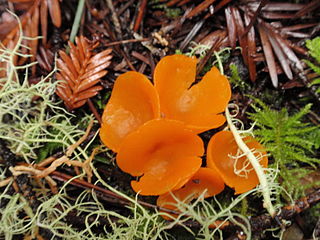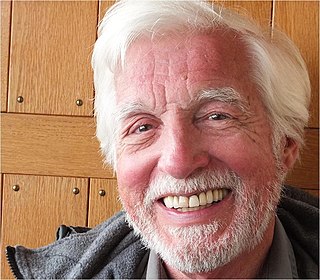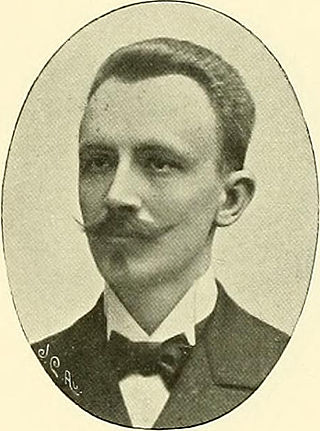
Edward Tuckerman was an American botanist and professor who made significant contributions to the study of lichens and other alpine plants. He was a founding member of the Natural History Society of Boston and most of his career was spent at Amherst College. He did the majority of his collecting on the slopes of Mount Washington in the White Mountains of New Hampshire. Tuckerman Ravine was named in his honor. The standard botanical author abbreviation Tuck. is applied to species he described.

Karl Wilhelm Gottlieb Leopold Fuckel was a German botanist who worked largely on fungi.

Exobasidium vaccinii, commonly known as “red leaf disease,” or “Azalea Gall,” is a biotrophic species of fungus that causes galls on ericaceous plant species, such as blueberry and azalea. Exobasidium vaccinii is considered the type species of the Exobasidium genus. As a member of the Ustilagomycota, it is a basidiomycete closely related to smut fungi. Karl Wilhelm Gottlieb Leopold Fuckel first described the species in 1861 under the basionym Fusidium vaccinii, but in 1867 Mikhail Stepanovich Voronin later placed it in the genus Exobasidium. The type specimen is from Germany, and it is held in the Swedish Museum of Natural History. Exobasidium vaccinii, in current definition from John Axel Nannfeldt in 1981, is limited on the host Vaccinium vitis-idaea. This idea is used in most recent papers on E. vaccinii.
Jafnea is a genus of fungi in the family Pyronemataceae. It was circumscribed by mycologist Richard Korf in 1960.
Nannfeldtiella is a genus of fungi in the family Pyronemataceae.

Sowerbyella is a genus of fungi in the family Pyronemataceae. The genus has a widespread distribution, and contains 17 species found mostly in Europe and China.

Galiella is a genus of fungi in the family Sarcosomataceae. The genus is widely distributed in northern temperate regions, and according to one estimate, contains eight species.

Job Bicknell Ellis was a pioneering North American mycologist known for his study of ascomycetes, especially the grouping of fungi called the Pyrenomycetes. Born and raised in New York, he worked as a teacher and farmer before developing an interest in mycology. He collected specimens extensively, and together with his wife, prepared 200,000 sets of dried fungal samples that were sent out to subscribers in series between 1878 and 1894. Together with colleagues William A. Kellerman and Benjamin Matlack Everhart, he founded the Journal of Mycology in 1885, forerunner to the modern journal Mycologia. He described over 4000 species of fungi, and his collection of over 100,000 specimens is currently housed at the herbarium of the New York Botanical Gardens. Ellis had over 100 taxa of fungi named in his honor.
Benjamin Matlack Everhart was an American mycologist from West Chester, Pennsylvania.
Nils Hylander was a Swedish botanist and mycologist. From November 1953 to his death he was curator of the Uppsala University Botanical Garden. He was appointed professor in 1967.

Albert Pilát was a Czech botanist and mycologist. He studied at the Faculty of Science at Charles University, under the guidance of Professor Josef Velenovský. In 1930, he joined the National Museum, eventually becoming head of the Mycological Department, and in 1960 a corresponding member of the academy. He was the author of many popular and scholarly publications in the field of mycology and mountain flora. He also served as the main editor of the scientific journal Czech Mycology, and described several species of fungi. His areas of particular interest include polypores and boletes. He explored the Carpathians looking for fungi and travelled widely. Between 1933 and 1948 he edited the exsiccata series Fungi Carpatici lignicoli exsiccati. He was also a skilled photographer.
Alexandre François Malbranche was a French pharmacist, botanist and mycologist. He is known for his botanical and mycological studies associated with Normandy,

František Bubák was a Czech mycologist and phytopathologist.

Kálmán Géza Vánky was a Hungarian mycologist with Swedish and Hungarian citizenship, who lived in Germany. He was considered to be the worldwide authority on the subject of smut fungi and has dominated the taxonomic study of Ustilaginomycetes for at least the past four decades.
George Knox Merrill was an American lichenologist. He was a leading exponent of lichenology in the early 20th century. He was particularly interested in species of the family Cladoniaceae, in which he published several new species, varieties, and forms. In 1909 he started publishing Lichenes Exsiccati, which he continued intermittently until 1927; 400 specimens were presented in two exsiccata series.

Gustaf Oskar Andersson Malme was a Swedish botanist.
Josef Anders was a Czech botanist and lichenologist.

Exobasidium parvifolii is a species of fungus.

Exsiccata is a work with "published, uniform, numbered set[s] of preserved specimens distributed with printed labels". Typically, exsiccatae refer to numbered collections of dried herbarium specimens or preserved biological samples published in several duplicate sets with a common theme or title, such as Lichenes Helvetici. Exsiccatae are regarded as scientific contributions of the editor(s) with characteristics from the library world and features from the herbarium world. Exsiccatae works represent a special method of scholarly communication. The text in the printed matters/published booklets is basically a list of labels (schedae) with information on each single numbered exsiccatal unit. Extensions of the concept occur.
Philipp Franz Wilhelm von Zwackh-Holzhausen was a German botanist and mycologist.












